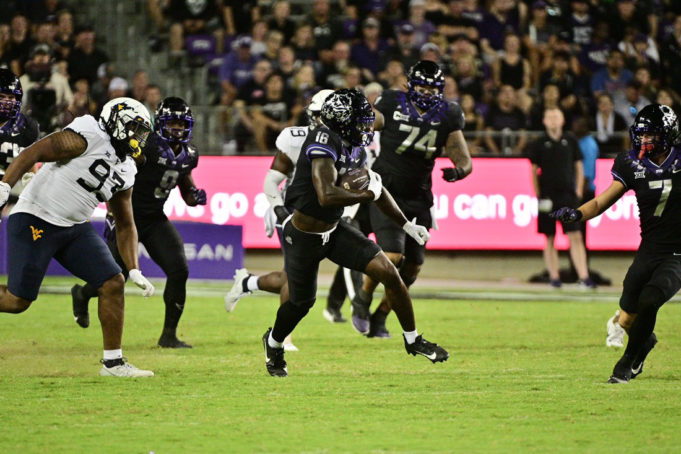Yesteryear’s formula of squeaking out nail biters has taken an abrupt and ugly turn toward mediocrity earlier than expected this season. I asserted weeks ago that Frog fanatics shouldn’t be expecting many comfortable wins this season, which has been only partially correct thus far. In fact, between Houston and SMU, the Horned Frogs — at least as far as the box score goes — have cruised to Ws by a combined 40 points.
Nerves were high hosting the Uptown Equestrians. SMU never led but were down by only four going into halftime as quarterback Preston Stone used his legs to hurt the TCU defense more often than his arm. An above-average third quarter by the Frog offense, mostly predicated by the rushing of both quarterback Chandler Morris and running back Emani Bailey, produced a touchdown and enough positive field position for two field goals that put the game beyond the gallop of the Ponies. Curiously, SMU chose to try and gash the Frogs on the ground more than exploit what had previously been a porous secondary. In my not-so-humble opinion, this win, much like the Houston one, was as much about the opponent’s poor execution and game plan than actual purple prowess. Still, TCU’ers now have a 10-game lead in the overall series with their second most-consistent opponent, and head coach Sonny Dykes has secured the Iron Skillet in four consecutive meetings (two for TCU and two for his previous employer, SMU).
In their first home conference game of the season last Saturday, TCU hosted the West Virginia Mountaineers, a team that has never been an easy out, no matter which Frog squad has been playing. Before joining the Big 12 in the same year, the schools had met only once, a WVU victory back in 1984. Since then, the Mountaineers have continued to confound the Frogs, winning four consecutive through the end of the Gary Patterson era. I thought, as probably many did, that playing the Mountaineers in Fort Worth might provide a more affable environment than Morgantown, where the thick scent of coal, burned couches, and crushed dreams lingers in the air.
Both squads entered the game 3-1, with WVU’s loss being a decisive opening-season defeat against now sixth-ranked Penn State. Since then, the Davy Crockett impersonators have beaten rival Pitt without allowing a touchdown and Texas Tech while giving up only 13 points. The TCU game began with a quick three-play drive from the Frogs in which Morris hit two of three passes, the final resulting in a 59-yard catch and run by JP Richardson, who shed a tackler to sprint straight up centerfield for a score. WVU responded with their own 70-plus-yard drive highlighted by a 30-yard pass from quarterback Garrett Greene, who followed that with a run of 35 yards.
The Frogs punched back with an effective drive of Morris and Bailey rushing incrementally down the field before being stymied by an intentional grounding flag against Morris, resulting in a missed field goal by Griffin Kell. The affair went back and forth until halftime, when West Virginia missed a desperation field goal to leave the score 21-14 TCU heading into the locker room.
Unfortunately, the Frog offense decided the facilities at Amon G. Carter are so luxurious, they’d stay inside for the rest of the evening. TCU didn’t score another point on Saturday in a second-half performance that Coach Dykes called one of the worst he’d ever seen. Odds are, if you get up and walk to the restroom while reading this, you’ll have traveled farther than TCU’s offense in the third quarter on Saturday, which was 1 total net yard. The offensive line played horribly, and four rushing Mountaineers regularly sacked and harassed Morris and generally made him look like he was running from personal demons.
In stark contrast to the offense, as well as their own recent performances, TCU’s defense acquitted themselves admirably in crunch situations during the third quarter, forcing turnovers on downs twice, including one at their own 1-yard line. The only second-half touchdown surrendered was on a drive when the Mountaineers started at the TCU 44 after the purple offense went three and out and lost yards. West Virginia’s field goal followed the goal-line stand, in which the Frog offense was able to gain 10 yards in five plays but still couldn’t provide their defense the luxury of defending more than 50 yards.
After falling behind for the first time, TCU’s offense wheezed to life and started at least threatening WVU territory. Their final two drives netted 52 and 48 yards, respectively, and both finished with blocked field goal attempts. That means Griffin Kell went zero for three on Saturday, the final two attempts being blocked. Add a muffed punt to the equation (which TCU did retain), and the special teams deserve a big fat “F.”
TCU’s offense, despite sleeping through the third quarter and their inability to convert on short-yardage fourth downs, did produce enough — in theory — to win this game. The purple defenders, who have been criticized early and often by me, were really the only reason the game stayed winnable. They played their best game of the season when no one else seemed ready. TCU’s young linebacking squad is still struggling with overrunning and blowing containment of mobile quarterbacks. Greene completed only 10 passes but rushed 12 times for 80 yards and two scores, leading the Mountaineers in both. His rushing average per attempt was barely lower than his passing.
Overall, between two interceptions against SMU and turning over WVU twice on downs, Joe Gillespie’s defense has been trending. The Mountaineer defenders have proven themselves very capable already through five games at least against average opponents — which it seems more and more that the Frogs are — so TCU’s offensive performance shouldn’t seem as jarring, especially considering one missed and two blocked field goals. It was their worst performance of the season but against the best defense they’ve faced.
Knock knock. Who’s there? TCU. TCU who? I have no freakin’ idea. That is perhaps the most frustrating part of experiencing Frog football this season, especially for diehards. Dykes’ sophomore squad has no identity. They don’t seem especially gritty but aren’t soft either. The defense looks awful at times but can pull off a second half to stay within striking distance against a decent team. The offense is inconsistent and Morris makes freshman-like mistakes but is still good for two touchdown passes in most games, and the offense has scored more than 30 points in four of five kickoffs this season. TCU has lost twice in borderline disgusting fashion when they could have won but against serviceable competition — who both still have winning records — by a combined six points.
Everyone loves preseason college football hype. It’s an essential part of the engine that keeps the industry churning, but no one really knows anything about any team until at least the beginning of conference play. But with Dykes and company, I feel like we know even less than when we started, which is comforting in a strange way. We can see that even against much better competition coming down the pike, the Frogs stand a chance, but it’s also absolutely infuriating knowing they could just as easily fall to a .500 record next week in Ames against a 2-3 Cyclone squad who has looked a hair above abysmal since beating Northern Iowa to start their season.
TCU has two winnable conference games coming up. After Iowa State, they host BYU. After that, the schedule seems — as of now — less manageable. If TCU wants a chance to compete for the conference title, albeit an outside one, they need to stack these victories now and hope the team is ready to put all three phases together on one Saturday when it’s time to play Kansas State, Oklahoma, or Texas later in the season.












